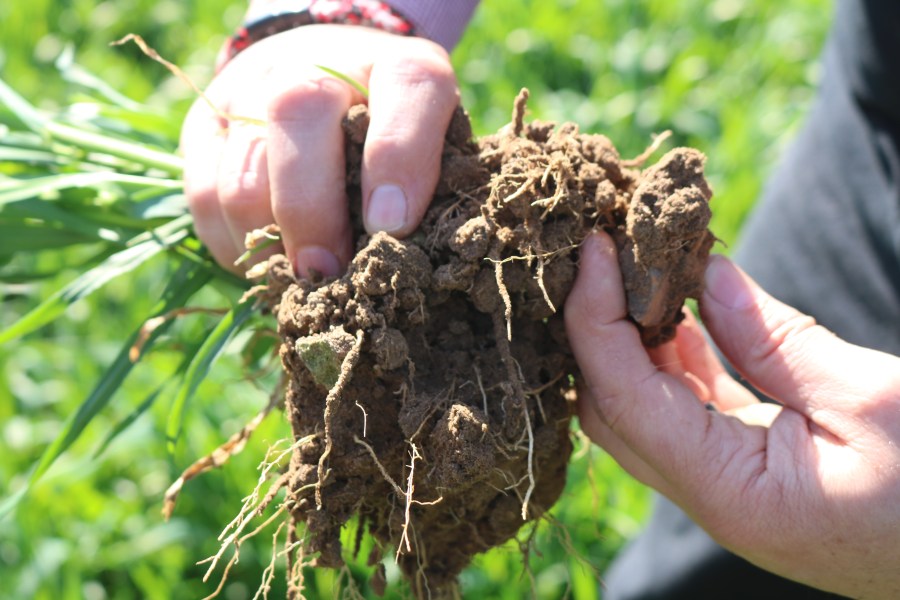Farmers and scientists from the TRUTH project have revealed initial findings from their first year of working together.
TRUTH (Thriving Roots Underpinning Total soil Health) is a three-year £1M project with the aim of boosting productivity while improving soil health. The work is led by the British On-Farm Innovation Network (BOFIN) supported by the UK Agri-Tech Centre, the John Innes Centre, University of Nottingham and PES Technologies.
Ten ‘Root Ranger’ farmers were paid to undertake on-farm trials in year one (2024), with an additional 10 recruited for year two. Root Rangers farms represent varied soil types across conventional, regenerative and organic systems – from East Lothian in Scotland to Downpatrick in Northern Ireland, and as far south as the Isle of Wight.
The farmers each chose a treatment to assess and have been trained in soil sampling methods.
UFOs
Dr Tom Thirkell of Crop Science Centre in Cambridge is an expert in mycorrhizal fungi which he’s been studying in the wheat root samples taken by the Root Rangers. As well as healthy populations of mycorrhiza, Tom’s analysis of the Root Rangers’ samples has also uncovered some ‘unidentified foreign organisms’ (UFOs).
While some of these appear to be bacteria, others are likely to belong to an ancient but newly-described group of fungi known as Mucoromycotina. Explaining more, tom says: “We believe these can also form beneficial interactions with cereal crop roots, but there’s been very little study of them compared with the arbuscular mycorrhizas.”
They were found in several samples and aren’t unique to a specific type of farm, he adds. “They’re random in how they crop up, but a strength of this project is we can repeat these tests in years two and three to see if there are patterns.”
Tom also hopes DNA sequencing of these samples may be possible in future, so that the ‘UFOs’ can be identified.
His findings from year one suggest variations in fungal presence are influenced more by individual farm management practices, rather than the different treatments being trialled, but repetition of sampling in years two and three will develop this understanding further.
Soil microbial diversity
Dr Maria Hernandez-Soriano of the John Innes Centre is leading an investigation into soil microbial diversity. Her work involves analysing DNA from soil samples collected by Root Rangers across 10 farms, revealing a staggering 15,686 individual species.
At the John Innes Centre laboratories in Norwich, around 222 samples from the Root Rangers were carefully processed to extract the DNA. The DNA was then prepared for sequencing to ensure the best quality analysis, and finally sent to a leading provider of sequencing services.
The scientists then compiled a ‘library’ of all the DNA found in the samples, naming matched sequences using extensive databases. The result is a vast spreadsheet listing all the individual species found in each sample – a total of 15,686 across the Root Rangers’ soils.
From there, the data was analysed, drawing comparisons across different systems and the whole dataset, but also drilling down into individual farms’ results to assess and compare diversity.
Maria says: “At the moment the results are suggesting management is the strongest influence.” In particular, she says the organic farmers among the Root Rangers had the most diverse samples with a significant difference in nitrification too.
Diversity is important because these microbes work together as part of a complex network, both in cooperation with each other and regulating their different roles in soil, highlights Maria. “It’s a huge community – some of which we know a lot about while others are yet to be characterised. Understanding the activity of nitrification bacteria helps in improving nitrogen use efficiency.”
She’s been looking closely at two of the most prevalent nitrifying communities, Nitrososphaera and Nitroscosmicus archaea. These have become the biomarkers in the rhizosphere of modern cultivars following N-fertiliser application, to the detriment of other communities, she explains.
“The abundance of these microbes in soil dramatically increases when you apply ammonium-based fertilisers, rapidly turning ammonium into nitrate, which is highly soluble and easily lost to the environment through leaching or gas emission as nitrous oxide.”
Rhizosphere
Year two of the project will focus more on the rhizosphere and now with 20 Root Rangers on board, the sampling should produce an even stronger dataset.
The Root Rangers have also been given a unique view of their soil structure and root systems through X-ray Computed Tomography (CT) scanning.
Dr Craig Sturrock of the University of Nottingham explains that CT scans were used to compare soil ‘cores’ from the different farms. The farmers took samples from their chosen fields of first winter wheat using sections of plastic pipe (15 cm x 8 cm). These were hammered into the ground before being carefully excavated to preserve the structure of the soil and roots inside.
Each of the Root Rangers took 10 samples in a typical w-formation, five samples from the treated area under scrutiny in their trials and five from the untreated area.
Craig says it’s been an exciting first year of the project – using the imaging technology to visualise the structure of soils across the UK, completely non-destructively, which is usually really difficult to see.
“We’ve found some nice differences between the soils. There’s variation between geographical location, soil texture, treatments, and differences in the root structure,” he adds.
The research highlights the impact of management practices, such as ploughing and grazing. But, the results weren’t always as expected, with ploughed soil showing minimal differences to min or no-till, he comments.
Craig believes this may have been related to the time of sample collection being relatively late in the growth season (May 2024), where the soil has had time to settle after cultivation the previous autumn. “This year we plan to sample in March so tillage differences between sites may be more apparent.”
In year two the Root Rangers will repeat the sampling process, but this time with five soil cores just from untreated areas.
Root Ranger feedback
Anna Pearce is an organic farmer and seed producer from Northumberland. She joined the TRUTH project as she was keen to work with scientists to learn more about the health of the soil on her farm.
“As farmers we don’t often get the opportunity to interact with scientists and this is a huge opportunity to be able to put our heads together,” she says.
Anna was particularly interested to find out how her soil compared with other farms and to see the soil core CT scans. “It’s fascinating to see pictures of what’s under the ground. It was reassuring to learn that my soil copes well with being lightly ploughed and that there’s enough life in it to repair any changes to structure.”
Hertfordshire farm manager Ted Allen-Stevens also welcomed the opportunity to take part in the project, particularly as it validated the introduction of regenerative practices on the farm. “When I saw our results from the TRUTH project I felt that I had some real evidence that soil health had improved since we brought in regenerative practices here.
“It’s only when you drill down into the detail of your own farm that you can get that substance and reassurance of what you’re actually achieving,” he says.
The second year of the project will build on the successes so far, with the soil/root testing tools under further scrutiny by the farmers and scientists. An innovative soil health sensor, developed by PES Technologies, will also be circulated amongst the Root Rangers who’ll put it through its paces. The sensor is designed to measure microbial diversity and fungal:bacterial ratio.
Also in year two, novel wheat varieties are being multiplied ready for trialling on Root Rangers’ farms in the final year of the project. These include a ‘remarkable’ variety that can moderate its own nitrogen supply. Originating from Iran, this particular wheat landrace is part of the historic Watkins collection at JIC.
Maria Hernandez-Soriano explains: “What’s interesting about this particular wheat is that it’s demonstrated capacity to decrease the transformation of ammonium into nitrate in the soil. This is believed to be an adaptive trait.”
She says this means much less nitrogen from fertilisers potentially being lost to the environment and more being taken up and used by the wheat plant itself, because it’s controlling the transformation in soil and optimising the uptake.
“We haven’t observed that same capability or trait in any commercial wheat cultivars yet, so that’s remarkable.”
Tom Allen-Stevens, managing director of the British On-Farm Innovation Network (BOFIN) which leads the project concludes: “The quality of samples and resulting data has proven again the value of on-farm trials and what can be gained when farmers and scientists work together.
“There’s a huge appetite among farmers to learn more about soil health. This project is paving the way for discoveries about how we can improve the long-term productivity of our farms through improved understanding and management of our most precious resource.”




